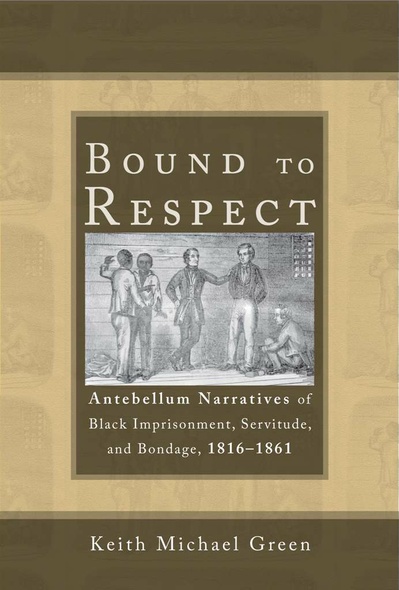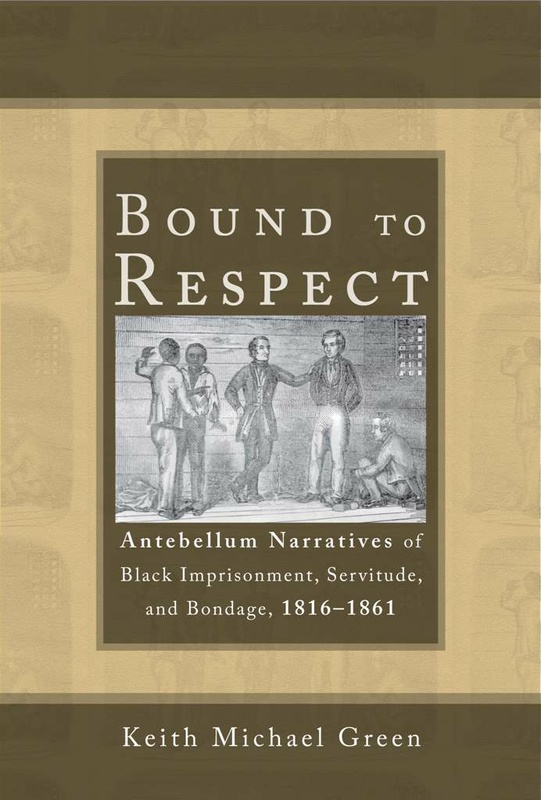Bound to Respect
Antebellum Narratives of Black Imprisonment, Servitude, and Bondage, 1816–1861
Challenges the commonplace narrative that the African American experience of captivity in the United States is reducible to the legal institution of slavery, a status remedied through emancipation
In Bound to Respect: Antebellum Narratives of Black Imprisonment, Servitude, and Bondage, 1816–1861, Keith Michael Green examines key texts that illuminate forms of black bondage and captivity that existed within and alongside slavery. In doing so, he restores to antebellum African American autobiographical writing the fascinating heterogeneity lost if the historical experiences of African Americans are attributed to slavery alone.
The book’s title is taken from the assertion by US Supreme Court chief justice Roger B. Taney in his 1857 Dred Scott decision that blacks had no rights that whites were “bound to respect.” This allusion highlights Green’s critical assertion that the dehumanizing absurdities to which defenders of slavery resorted to justify slavery only brought into more stark relief the humanity of African Americans.
A gifted storyteller, Green examines four forms of captivity: incarceration, enslavement to Native Americans, child indentured servitude, and maritime capture. By illuminating this dense penumbra of captivity beyond the strict definitions of slavery, he presents a fluid and holistic network of images, vocabulary, narratives, and history. By demonstrating how these additional forms of confinement flourished in the era of slavery, Green shows how they persisted beyond emancipation, in such a way that freed slaves did not in fact partake of “freedom” as white Americans understood it. This gap in understanding continues to bedevil contemporary American society, and Green deftly draws persuasive connections between past and present.
A vital and convincing offering to readers of literary criticism, African American studies, and American history, Green’s Bound to Respect brings fresh and nuanced insights to this fundamental chapter in the American story.
Green provides new insight and perspective on slave narratives and, thus, the works borne out of those narratives. For students of history, the book can be used as a companion to the works analyzed within the text and as a reminder of the complex and intricate nature of African American history and heritage.'
—The Alabama Review
'By using underappreciated accounts of African American bondage, [Bound to Respect] asserts the heterogeneity of black bondage [and] facilitates two of the goals of almost all pre-Civil War black writing: legitimizing claims to personhood and framing articulations of protest.'
—American Literature
‘This is a provocative and important book. Bound to Respect gets at the difficult history of the recognition of African American humanity and liberty by expanding our understanding of the means by which that recognition was denied or restricted. This is a study that gets at the complexity of African American identity, the overlapping levels of experience, and the nesting dolls of African American confinements that are involved in the construction of African American cultures of consciousness and understanding.’
—John Ernest, author of A Nation Within a Nation: Organizing African-American Communities before the Civil War and Liberation Historiography: African American Writers and the Challenge of History, 1794–1861
Keith Green’s Bound to Respect will assume an important place alongside earlier studies of African and African American captivity. Green has taken to heart Roderick Ferguson’s call to rethink narrow, plot-driven analyses of black history. He instead reroutes his readings of slave narratives through the vexed terrain of black ‘respectability politics.’ This unexpected turn expands notions of bondage beyond whips, chains, and plantations into the realms of political and affective imprisonment. The results are gratifying.’
—Jennifer James, author of A Freedom Bought with Blood: African American War Literature from the Civil War to World War II
List of Illustrations
Acknowledgments
1. Uncommon Sufferings: Rethinking Bondage in Narrative of the Uncommon Sufferings and Surprizing Deliverance of Briton Hammon, A Negro Man,—Servant to General Winslow, of Marshfield, in New-England
I. Bound in Slavery
2. Imprisoned Slaves, Genteel Slaveholders, and Virtuous Prisoners: Slave Incarceration in Incidents in the Life of a Slave Girl, Written by Herself
3. Mild Masters, Sympathetic Abolitionists, and Courageous Husbands: Cherokee Slavery in The Life and Adventures of Henry Bibb, an American Slave
II. Bound in Freedom
4. Bound Children, Benevolent Caretakers, and Disabling Service: Indentured Servitude in Harriet Wilson’s Our Nig
5. Savage Moors, African Companies, and Mulatto Explorers: North African Captivity in The Narrative of Robert Adams
Epilogue: Imprisonment and Domestic Captivity in The Color PurpleNotes
Works Cited
Index







